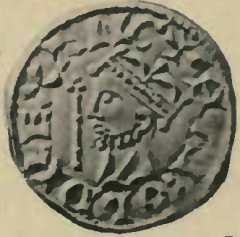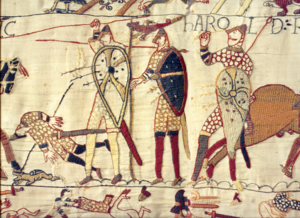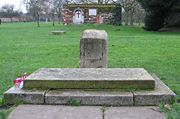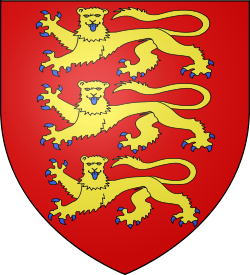Harold Godwinson
| Harold Godwinson | |
|---|---|
| King of England (more...) | |
 |
|
| Reign | 5 January — 14 October 1066 |
| Coronation | 6 January 1066 |
| Predecessor | Edward the Confessor |
| Successor | Edgar the Ætheling or William the Conqueror |
| Spouse | Edith Swanneck Edith of Mercia |
| Issue | Godwin Edmund Magnus Gunhild Gytha Harold Ulf |
| Full name | Harold Godwinson |
| Royal house | House of Godwin |
| Father | Godwin, Earl of Wessex |
| Mother | Gytha Thorkelsdóttir |
| Born | Circa 1022 Wessex, England |
| Died | 14 October 1066 Battle of Hastings, Sussex |
| Burial | Waltham Abbey, Essex, or Bosham -disputed |
Harold Godwinson (c. 1022 – October 14, 1066) also known as Harold II, is widely regarded as the last Anglo-Saxon King of England before the Norman Conquest.[1] Harold reigned from 5 January 1066, until his death at the Battle of Hastings on 14 October of that same year, fighting the Norman invaders, led by William the Conqueror.
Contents |
Family Background
Harold was son of Godwin, the powerful Earl of Wessex, and his wife Gytha Thorkelsdóttir, whose supposed brother Ulf Jarl was the son-in-law of Sweyn I and the father of Sweyn II of Denmark. Godwin and Gytha had several children, notably sons Sweyn, Harold, Tostig, Gyrth and Leofwine and a daughter, Edith of Wessex (1020–75), who became the Queen consort of Edward the Confessor.
Powerful nobleman
As a result of his sister's marriage to the king, Godwin's second son Harold was made Earl of East Anglia in 1045. Harold accompanied Godwin into exile in 1051, but helped him to regain his position a year later. When Godwin died in 1053, Harold succeeded him as Earl of Wessex (a province at that time covering the southernmost third of England). This made him arguably the most powerful figure in England after the king.
In 1058 Harold also became Earl of Hereford, and replaced his late father as the focus of opposition to growing Norman influence in England under the restored English monarchy (1042–66) of Edward the Confessor, who had spent more than a quarter of a century in exile in Normandy.
He gained glory in a series of campaigns (1062–63) against the ruler of Gwynedd, Gruffydd ap Llywelyn, who had conquered all of Wales; this conflict ended with Gruffydd's defeat and death (at the hands of his own troops) in 1063.
In 1064, Harold was apparently shipwrecked in Ponthieu. There is much speculation about this voyage. The earliest post-conquest Norman chroniclers report that at some prior time, Robert, Archbishop of Canterbury had been sent by the childless king to appoint as his heir Edward's maternal kinsman, William of Normandy, and that at this later date Harold was sent to swear fealty.[2] Scholars disagree as to the reliability of this story. William, at least, seems to have believed he had been offered the succession, but there must have been some confusion either on William's part or perhaps by both men, since the English succession was neither inherited nor determined by the sitting monarch. Instead the Witenagemot (the assembly of the kingdom's leading notables) would convene after a king's death to select a successor. Other acts of Edward are inconsistent with his having made such a promise, such as his efforts to return his nephew Edward the Exile, son of king Edmund Ironside, from Hungary in 1057.[3] Later Norman chroniclers suggest alternative explanations for Harold's journey, that he was seeking the release of members of his family who had been held hostage since Godwin's exile in 1051, or even that he had simply been traveling along the English coast on a hunting and fishing expedition and had been driven across the channel by an unexpected storm. There is general agreement that he left from Bosham, and was blown off course, landing on the coast of Ponthieu, where he was held hostage by Count Guy. Duke William arrived soon after and ordered Guy to turn Harold over to him.[4]
Harold then (apparently) accompanied William to battle against William's enemy, Conan II, Duke of Brittany. While crossing into Brittany past the fortified abbey of Mont St Michel, Harold is recorded to have rescued two of William's soldiers from the quicksand. They pursued Conan from Dol de Bretagne, then to Rennes, and finally to Dinan, where he surrendered the fortress's keys on the point of a lance. William presented Harold with weapons and arms, knighting him. The Bayeux Tapestry, and other Norman sources, then record that Harold swore an oath on sacred relics to William to support his claim to the English throne. After Harold's death, the Normans were quick to point out that in accepting the crown of England, Harold had perjured himself of this oath.
The chronicler Orderic Vitalis wrote: "This Englishman was very tall and handsome, remarkable for his physical strength, his courage and eloquence, his ready jests and acts of valour. But what were these gifts to him without honour, which is the root of all good?".
Due to an unjust doubling of taxation instituted by Tostig in 1065 that threatened to plunge England into Civil War, Harold supported Northumbrian rebels against his brother Tostig and replaced him with Morcar. This strengthened his acceptability as Edward's successor, but fatally divided his own family, driving Tostig into alliance with King Harald Hardrada ("Hard Reign") of Norway.
Marriages and children
For some twenty years Harold was married More danico (in the Danish manner) to Edith Swannesha and had at least six children by her. The marriage was widely accepted by the laity, although Edith was considered Harold's mistress by the clergy. Their children were not treated as illegitimate. Among them was a daughter Gytha, later wife of the Russian prince Vladimir Monomakh. Through descendants of this Anglo-Russian marriage, Harold is thus the ancestor of later English kings.
About January 1066, Harold married Edith (or Ealdgyth), daughter of Ælfgar, Earl of Mercia, and widow of the Welsh prince Gruffydd ap Llywelyn. Edith had two sons — possibly twins — named Harold and Ulf (born c. November 1066), both of whom survived into adulthood and probably ended their lives in exile.
After her husband's death, the queen is said to have fled for refuge to her brothers Edwin, Earl of Mercia and Morcar of Northumbria but both men made their peace with the Conqueror initially before rebelling and losing their lands and lives. Aldith may have fled abroad (possibly with Harold's mother, Gytha, or with Harold's daughter, Gytha).
Reign as king
At the end of 1065, king Edward the Confessor ailed and fell into a coma without clarifying his preference for the succession. On January 4, 1066, according to the Vita Ædwardi Regis, he died, but not before briefly regaining consciousness and commending his widow and the kingdom to Harold's "protection". The intent of this charge is ambiguous, as is the Bayeux Tapestry, which simply depicts Edward pointing at a man thought to represent Harold.[5] When the Witenagemot convened the next day, they selected Harold to succeed,[6] and his coronation followed on January 6, the first coronation in Westminster Abbey. Although later Norman sources point to the suddenness of this coronation, it is possible that it took place whilst all the nobles of the land were present at Westminster for the feast of Epiphany and not because of any usurpation of the throne on Harold's part.


In early January of 1066, hearing that Harold had been crowned King, William Duke of Normandy began plans to invade by building 700 warships and transports at Dives-sur-Mer on the Normandy coast. Initially William could not get support for the invasion but, claiming that Harold had sworn on sacred relics to support his claim to the throne after having been shipwrecked in Ponthieu, William was given the Church's blessing and nobles flocked to his cause. In anticipation of the invasion, Harold assembled his troops on the Isle of Wight but, claiming unfavourable winds, the invasion fleet remained in port. On September 8 with provisions running out Harold disbanded the army and he returned to London. On the same day Harald Hardrada of Norway, who also claimed the English crown[7] joined Tostig and invaded, landing his fleet at the mouth of the Tyne.
Invading what is now Yorkshire, Harald Hardrada and Tostig defeated the English earls Edwin of Mercia and Morcar of Northumbria at the Battle of Fulford near York on 20 September. They were in turn defeated and slain by Harold's army five days later at the Battle of Stamford Bridge, Harold having led his army north on a forced march from London in four days and caught them by surprise. According to Snorri Sturluson, before the battle a man bravely rode up to Harald Hardrada and Tostig and offered Tostig his earldom if he would but turn on Harald Hardrada. When Tostig asked what his brother Harold would be willing to give Harald Hardrada for his trouble, the rider replied that he would be given seven feet of ground as he was taller than other men. Harald Hardrada was impressed with the rider and asked Tostig his name, Tostig replied that the rider was none other than Harold Godwinson.[8] According to Henry of Huntingdon, "Six feet of ground or as much more as he needs, as he is taller than most men," was Harold's response. It is, however, unknown whether this conversation ever took place.
On September 12 William's fleet sailed.[9] Several ships sank in storms and the fleet was forced to take shelter at Saint-Valery-sur-Somme and wait for the wind to change. On September 27 the Norman fleet finally set sail for England arriving it is believed the following day at Pevensey on the coast of East Sussex. Harold now again forced his army to march 241 miles (386 kilometres) to intercept William, who had landed perhaps 7000 men in Sussex, southern England. Harold established his army in hastily built earthworks near Hastings. The two armies clashed at the Battle of Hastings, near Senlac Hill (the present town of Battle) close by Hastings on 14th October, where after nine hours of hard fighting and less than 30 minutes from victory Harold was killed and his forces routed.[10] His brothers Gyrth and Leofwine were also killed in the battle. According to tradition, Harold was killed by an arrow in the eye, but it is unclear if the victim depicted in the Bayeux Tapestry is intended to be Harold, or whether indeed the tapestry's scene depicts that particular type of wound.[11] Whether he did, indeed, die in this manner (a death associated in the Middle Ages with perjurers), or was killed by the sword, will probably never be known. Harold's wife, Edith Swannesha, was called to identify the body, which she did by some private mark known only to herself.
Harold's body was buried in a grave of stones overlooking the shore, and was only given a proper funeral years later in his church of Waltham Holy Cross in Essex, which he had refounded in 1060.[12]
Harold's strong association with Bosham, his birthplace, and the discovery of an Anglo-Saxon coffin in the church in 1954 has led some to speculate that King Harold was buried there. A request to exhume a grave in Bosham church was refused by the Diocese of Chichester in December 2003, the Chancellor ruling that the chances of establishing the identity of the body as Harold's were too slim to justify disturbing a burial place.[13] A prior exhumation had revealed the remains of a man, estimated at up to 60 years of age from photographs of the remains, lacking a head, one leg and the lower part of his other leg, a description consistent with the fate of the king as depicted in "Carmen de Hastingae Proelio" (the Song of the Battle of Hastings) written shortly after the battle by Guy, Bishop of Amiens although the poem also claims Harold was buried by the sea which eliminates Bosham.[14]
There is a legend that Henry I of England met an elderly monk at Waltham Abbey, who was in fact a very old Harold. King Harold had a son posthumously called Harold Haroldsson who may have been this man, and may also be the occupant of the alleged grave.
Legacy and legend

Harold's daughter Gytha of Wessex married Vladimir Monomakh Grand Duke (Velikii Kniaz) of Kievan Rus' and is ancestor to dynasties of Galicia, Smolensk, and Yaroslavl, whose scions include Modest Mussorgsky and Peter Kropotkin. Isabella of France (consort of Edward II) was also a direct descendant of Harold via Gytha, and thus the bloodline of Harold was re-introduced to the Royal Line. Subsequently, undocumented claims that the Russian Orthodox Church has recently recognised Harold as a martyr have been made. Ulf, along with Morcar and two others, were released from prison by King William as he lay dying in 1087. He threw his lot in with Robert Curthose, who knighted him, and disappeared from history. Two of his elder half-brothers, Godwine and Magnus, made a number of attempts at invading England in 1068 and 1069 with the aid of Diarmait mac Mail na mBo. They raided Cornwall as late as 1082, but died in obscurity in Ireland.
Legend
A cult of hero-worship rose around Harold, and by the 12th century, legend says that Harold had indeed survived the battle, had spent two years in Winchester after the battle recovering from his wounds, and then travelled to Germany, where he spent years wandering as a pilgrim. As an old man, he supposedly returned to England, and lived as a hermit in a cave near Dover. As he lay dying, he confessed that although he went by the name of Christian, he had been born Harold Godwinson. Various versions of this story persisted throughout the Middle Ages, but have little basis in fact. Harold's wife was pregnant with a son when he died, whom she named "Harold" and he became a monk at Waltham Abbey and is said to have met Henry I, leading to the idea that Harold Godwinson had survived, instead of Harold Haroldson.
In popular culture
Literary interest in Harold revived in the 19th century, with the play Harold, by Alfred, Lord Tennyson, in 1876; and the novel Last of the Saxon Kings, by Edward Bulwer-Lytton, in 1848. Rudyard Kipling wrote a story, The Tree of Justice (1910), describing how an old man who turns out to be Harold is brought before Henry I. E. A. Freeman wrote a serious history in History of the Norman Conquest of England (1870–79), in which Harold is seen as a great English hero. Fictional accounts based on the events surrounding Harold's struggle for and brief reign as king of England have been published, notably "The Golden Warrior" by Hope Muntz, "The Interim King" by James McMilla, "Lord of Sunset" by Parke Godwin, and The Last English King by Julian Rathbone.
The one-act play A Choice of Kings by John Mortimer deals with his deception by William after his shipwreck.
On screen, Harold has been portrayed by Rex Reason in the film Lady Godiva of Coventry (1955), Patrick Newell in the comedy film Father Came Too! (1962), Michael Craig in a TV adaptation of A Choice of Kings in the ITV Play of the Week series (1966), Barrie Ingham in the two-part BBC TV play Conquest (1966; part of the series Theatre 625), Norman Chappell in an episode of the TV comedy series Carry On Laughing entitled "One in the Eye for Harold" (1975), and Jâms Thomas in an episode of the British educational TV series Historyonics entitled "1066" (2004).
See also
- House of Wessex family tree
References
- ↑ It could be argued that Edgar the Atheling, who was proclaimed as king by the witan but never crowned, was really the last Anglo-Saxon king.
- ↑ David Howarth, 1066: The Year of the Conquest, Penguin Books, 1983, pp. 69-70; Elisabeth van Houts, ed. The Gesta Normannorum Ducum of William of Jumieges, Orderic Vitalis and Robert of Torigni, Clarendon Press: Oxford, 1995, vol. 2, pp. 158-61
- ↑ Howarth, 1066: The Year of the Conquest, pp. 69-70. Edward may not have been blameless in this situation, as at least one other man, Sweyn II of Denmark, also thought Edward had promised him the succession.
- ↑ Howarth, 1066: The Year of the Conquest, pp. 71-72
- ↑ Frank Barlow, Edward the Confessor, University of California Press: Los Angeles, 1970, p. 251. Barlow points out that the author of the Vita, who appears to have looked favorably on Harold, was writing after the Conquest and may have been intentionally vague.
- ↑ This was in preference to Edward's great-nephew, Edgar Ætheling, who had yet to reach maturity.
- ↑ His claim came through a succession pact concluded between Harthacanute of England and Denmark and Magnus I of Norway, whereby the kingdoms of the first to die were to pass to the survivor. Magnus had thus gained Denmark on Harthacanute's death but had not pursued the other crown. Hardrada, uncle and heir of Magnus, now claimed England on this basis.
- ↑ Sturluson, Snorri (1966). King Harald's Saga. Baltimore, Maryland: Penguin Books. pp. 149.
- ↑ Historians do not accept that from January to September the wind was never favourable for an invasion as William claimed. It is generally believed he knew of Harald Hardrada's plans and waited for Harold Godwinson to be weakened or engaged with fighting in the north before he proceeded with his own plans.
- ↑ Battles of the time rarely lasted more than two hours before the weaker side capitulated, nine hours indicates the determination of William. William's forces had already recovered from a near rout after reports he had been killed but William raised his visor to prove he was alive and his men rallied. Battles were also not fought at night and as Harold would recieve fresh reinforcements in the morning he was assured of victory. Harold was killed shortly before sunset.
- ↑ Historians are divided over whether the Bayeux Tapestry depicts Harold being shot in the eye (the figure that has his name above) or whether Harold is actually the next figure being mutilated beneath a horses hooves (these mutilations being as described by contemporary accounts as happening to Harold. Examination has shown that the second figure once had an arrow in it's eye that had later been unstitched and consensus is growing that both figures are Harold showing the arrow that felled but did not kill him and his subsequent death and mutilation at the hands of a knight.
- ↑ Hilliam, Paul (2005). William the Conqueror: First Norman King of England. New York City, New York: Rosen Publishing Group. pp. 57. ISBN 1-4042-0166-1.
- ↑ In re Holy Trinity, Bosham [2004] Fam 124 — decision of the Chichester Consistory Court regarding opening King Harold's supposed grave.
- ↑ The Debate concerning the remains found in Bosham Church Bosham Online Magazine November 25, 2003 Updated to include the Chancellor's ruling of December 10, 2003
Bibliography
- Biography by P. Compton (1961); F. M. Stenton, Anglo-Saxon England (3d ed. 1971).
- Biography by Ian W. Walker: Harold: The Last Anglo-Saxon King. Sutton Publishing, Stroud, Gloucestershire, 1997. ISBN 0-7509-1388-6
External links
- audio drama documentary about the events of 1066 focusing on the North of England
- Genealogy page — Reliability unknown
- Profile of Harold Godwinson
- Descendants of King Cerdic of Wessex chart
- In the footsteps of King Harold A timeline of Harold Godwinson's life, includes information about places significant to Harold II's story.
- BBC Historic Figures: Harold II (Godwineson) (c.1020 - 1066)
- Britannica: Harold II (c. 1020 - Oct. 14, 1066)
- King Harold II ca.1021-1066 Extensive and useful site, graphics-heavy, can be a little slow loading.
- Geoff Boxell Harold Godwinson — the last king of the English The rise and fall of King Harold II.
- Regia Anglorum Kingmakers — The Story of the House of Godwin
- Steven Lowe The Godwins — A family of power
- "Harold: this insane Englishman" Contemporary accounts of Harold's accession and the Norman invasion.
- The Death of Harold Godwinson A commentary using the Bayeaux Tapestry as a primary source of information.
- A castle possibly built by Harold when he was earl of Hereford
Literature
| Preceded by Edward the Confessor |
King of England 1066 |
Succeeded by Edgar Ætheling (Proclaimed king by witan, never crowned) |
| Preceded by Godwin |
Earl of Wessex 1053–1066 |
Succeeded by Merged in Crown |
| Preceded by Ælfgār |
Earl of East Anglia 1052–1053 |
Succeeded by Ælfgār |
|
|||||||||||
